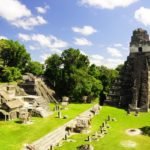How Guatemalan Traditions Are Expressed Through Stunning Textiles

¡Que chilero! is a Guatemalan saying for something that is amazing or impressive. This is how I describe marketplaces in Guatemala that are brimming with a vast array of traditional, multi-coloured textiles.
Truth is, Guatemalan textiles are not only unique because of their designs and colours, but also because they are deeply rooted in Guatemalan traditions.
The composition of the different kinds of textiles used in the making of Mayan Indian clothes is quite unique. Hence, during the last couple of weeks, I have been visiting distinct local markets to learn more about how these clothes come to be. Each one of them is a piece of art because they use textile as a form of expression.
Why are these textiles unique?
They possess a variety of colours. You find green, yellow, blue, purple, red…almost every shade is present. I was amazed to watch how the weaver incredibly managed to insert several designs of different textures and create a beautiful garment.
No one knows exactly when or how these costumes became a local tradition. However, it is known that a mechanism of standardization was used within villages in Guatemala during the Spanish Conquest to control the Indians. These colourful garments beautifully combine various elements from the textiles with old traditions to illuminate Guatemalan villages in a unique way.
What is the composition of a textile?
A traditional Mayan Indian costume is composed of the following elements despite possible geographic differences:
• Hüipils or colourful blouses that have developed from simple tops to elaborate garments decorated with impressive embroidery
• Corte or skirts worn by women and by men in some villages
• Sash or a unique ribbon used around the body
• Hair ribbon
• Tzute or a cloth used in ceremonial acts
Who wears them?
Due to its function as an identity uniform, the whole Mayan Indian garment used to be worn by men and women. However, because of the introduction of Western ideas, not all men wear them anymore. Men have more interaction and communication with life outside the village and have modified their traditional costume into a more westernized style of dress.
How do they differ from each other?
Each village successfully integrates distinct elements in their clothes to make them unique. Every single garment has a historical purpose and a symbolic meaning. Through exquisite brocades and embroideries, weavers create clothes covered with unique patterns and shapes that make each garment a piece of art.
Common elements used are birds, flowers, trees and others to symbolize universal virtues ranging from freedom and spirituality to knowledge. Some specialists have learned more about the different Mayan Indian villages from studying the patterns and symbols expressed through the textiles and costumes.
How have they changed through time?
How Guatemalan Traditions Are Expressed Through Stunning Textiles
Implementation of new elements to the garments has, indeed, modified them. These textiles are a work of art, and as such, are vulnerable to change. Some artists make them more colourful or extravagant to add their personal touch. As these textiles have gained international attention, demand has increased to produce Westernized garments.
Now, everyone can buy a handbag, shirt, or skirt made of these colourful textiles to express a bit of Guatemalan tradition and culture.
Have you traveled to Guatemala? How was your trip? Email us at [email protected] for information about sharing your experience and advice with the Pink Pangea community. We can’t wait to hear from you. Photo by Unsplash.








